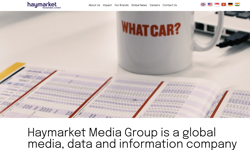The key decisions for a publisher with overseas readers are how fast you want the product to get there and what exactly you want them to receive. If they are not already buying a subscription or signed up for free copies you probably want to encourage them to remedy that.
There are several ways to get magazines and directories to overseas clients – courier, Priority Mail (what we used to call Air Mail), Economy Mail (that was Surface), and Royal Mail’s version of Economy Mail. A quick look at other postal websites around the world reveals that whilst Royal Mail International think Economy means "it’ll get there eventually", most other administrations interpret Economy as meaning delivery in 2-4 weeks. RMI call that Standard, but unfortunately they don’t offer it to all destinations.
The first decision then is which service level to use. If you publish weekly or fortnightly the choice is between courier and Priority, according to the immediacy of your content and the subscription price the market will stand.
If you publish less frequently there is a wider choice of delivery speeds. For adjacent countries I’d opt for Economy Mail services. The upgrade to Priority Mail is rarely worth the additional cost on distances like Ireland, France, Spain, Switzerland, BeNeLux, Germany, Austria, and Denmark. For the rest of Europe you might upgrade the paying readers and advertising contacts to Priority, leaving the free and promotional copies on Economy.
Beyond Europe it is worth looking at the cost of Royal Mail’s Standard offering (where it is available) against the Economy option from other European postal operators. Sometimes the others work out cheaper and they cover the whole of a continent at the Economy rate, not just RMI’s selected destinations.
For these services you will need to work through a Consolidator who may well have access to Direct Entry services as well. Direct Entry offers similar delivery targets for a great deal less than any European postal service would charge. Operators will airfreight mail and packets to a single country or to a group of adjacent countries and then deliver in the main cities themselves. They may leave the local postal service to handle the more remote deliveries – but purchased locally, rather than paying the kind of rates RMI and the other Europeans charge for access to the same destinations.
Choosing between various operators and Direct Entry providers can get complicated. Apart from price differences (with separate kilo and unit rates for many destinations), each operator has a different definition of world zones. Is Egypt best counted as part of the Middle East under Royal Mail Standard or as part of Africa with LaPoste France Economique, for example?
For a long time UK publishers took the view that we publish in English from Britian so we should be seen to be using Royal Mail. As long as you set some limits, it really is both safe and to your financial advantage to move away from an RMI only policy. But when you consider other operators, put yourself in the recipient’s position. Will the envelope or wrapper look odd to them if it shows a French or Swiss postmark ? Almost certainly not.
I’m happy to use most western European operators to most other world destinations. Readers assume that if mail has a particular postmark it has been through that country first. That is frequently not the case, but we don’t need to waste time explaining to a complainant that what looks like foreign mail was actually booked onto direct flights from London.
So avoid routes which appear illogical. Whilst Singapore might be a good option for the Far East and Australasia, readers may question why a UK publisher uses it for Africa and the Americas. Once they are asking questions about your routing the reader may lose confidence in the product.
Consolidators come in different types (I could have said sizes, it’s often a fair guide to their service range). Some Consolidators simply collect post from a number of clients and sort it into sacks for the services of a single European operator – Royal Mail International, LaPoste, Deutsche Post, perhaps. Some offer this, plus a few direct entry routes, principally the US Postal Service.
Others will use a broader range of suppliers, taking the cheapest option for each service level, item weight, destination and format (letter, large envelope or packet). So this month’s nice heavy edition of your magazine travels to Spain by LaPoste whilst next month’s thinner one might go by RMI. They are both going to be passed to the Spanish Post Office for doorstep delivery anyway.
Look for an operator who offers a range of reliable options. That would include several European operators, the US Postal Service (if you have enough US copies) and some Direct Entry routes.
When you are choosing a Consolidator it is worth looking at the other services they offer. You can of course pass them ready-wrapped product as it comes out of your printer-mailer’s works. But several of the Consolidtaors offer a full range of data manipulation, wrapping and inserting services. For example, they might produce carrier sheets which, for advertising contacts, existing subscribers or registered readers, merely show the address, returns address and the correct postmark. New prospects and lapsing readers can then be given personalised carriers which also show how to pay or sign up online, or which have a faxable form on the reverse.
Once you are into personalised carriers, think about how to use them to the full. You might promote sister publications or linked seminars and exhibitions. It’s easy to bring attention to particular coverage in this issue, to strengthen an advertiser’s message, or to ask your readers sponsored questions on behalf of an advertiser. After all, you are paying to produce and insert the carrier sheet and you are paying the extra grams of postage on it, so make it pay for itself.
It is also worth thinking about your daily office mail. If you have readers in foreign countries, you probably have advertisers there too, and you will certainly want to send promotional mailings and renewal invoices to your readers.
A number of firms operate vans which can call at your office two or three times a week, even daily, and take away your international post for consolidation. They may already call on you or on a neighbour, so the cost of picking up your international post is going to be a minimal add-on for them. Talk to your parcel or courier service provider about their international mail services. They almost all operate some form of consolidation in-house, or have connections with one of the major UK consolidators. Either way, you will save on international postage costs. Some operators can also handle the cost centre analysis publishers generally require.
There have been some steep price hikes on international mail over the last few years, so add up your invoices for the last 6 months and let a few operators know just how much your account could be worth to them. Don’t expect to find a single consolidator who is ideal for your office and promotional mail as well as for your magazine and directory distribution. It is best to assume you are going to review the two accounts separately, and review your consolidators every two to three years so you really see the savings.
Transparency is the keyword in consolidation. You can avoid the horror stories if you ask the right questions, and make clear your own ground rules – which routes and providers you would not be happy to use. And don’t be afraid to change the rules when you discover that a route has stopped working, just try not to do it on the basis of a single complainant. The error might be in the recipient’s building or in the address on your system, after all.
FEATURE
Choosing the ideal international option
As group circulation manager of Wilmington Media, Peter Steadman is responsible for the physical distribution of all Wilmington group magazines, directories and office mail. Here he offers his thoughts on how publishers can get the most out of their international post.










